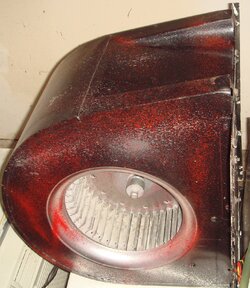I figured my 120 x 38mm high speed, 100CFM, toyo fan would at least make a diff in GPU temps, because it was blowing right at the end of the video card (maybe an inch away), but it never did, it just made noise. Maybe because there was too much restriction on the intake side (it was filtered and went through a grill that was much smaller than the 120mm fan).
I know ED doesn't like to hear about rack mount servers, but if you look at his picture you can see the baffles that direct all the airflow through the CPU's heatsink assembly and the DIMM's. The fans in the IBM x3550's I'm familiar with run at 6000RPM, so I bet they have high airflow, high static pressure and lots of sound pressure.
Intel wrote a white paper from 2008 called Thermally Advantaged Chassis,
it suggested a design that featured only three fans and a single intake vent of a particular size and placement. The fans were a PSU fan, CPU heatsink fan and one exhaust fan. Case pressurization isn't brought up in the white paper but airflow was.

